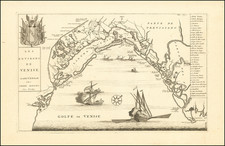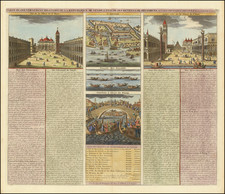Carte Du Plan De Venise, L'Etat De Sa Noblesse, et ses Differns Degrez, avec Quelques Autres Remarques Curieuses sur Cette Superbe Ville, prepared by Henri Chatelain and printed in Amsterdam in 1719, stands as a comprehensive portrayal of Venice's early 18th-century landscape. Through vividly depicted canals, buildings, and islands, the map delves deeply into the heart of the Venetian Republic, shedding light on its nobility and the intricate web of familial influence that once underscored Venetian society.
Venice, in the early 18th century, was renowned for its distinctive blend of power, commerce, and artistry. As the 'Serenissima' Republic, Venice had managed to retain its independence amid the turbulence of Europe, carving out a unique identity on the international stage. The city's power dynamics, embodied in the figure of the Doge and the influential families around him, played a pivotal role in this. The map, with the accompanying text, highlights these families, detailing their contributions and influence within the Republic, from the famed Doges they birthed to their various other accomplishments.
In this map, Chatelain's craftsmanship beautifully marries art with history. The portrayal of Venice with its interconnected canals and islands captures not just its geographical attributes but offers a gateway into understanding the administrative and societal structures. The lower text, citing families such as Morofini, Gradenigues, and Contarini, serves as a testament to the heritage and legacies carried forward by these names, elucidating their roles in shaping Venice's history.
Beyond its intricate details, the map also acts as a broader reflection on the nature of power and legacy in the pre-modern world. Venice's nobility, with their intertwined histories and the continuous influence they held over the Republic, mirrors the patterns seen in other European city-states and kingdoms. By studying this map, one not only gains insight into Venice's grandeur but also a deeper understanding of how familial legacies can shape the course of history.
Henri Abraham Chatelain (1684-1743) was a Huguenot pastor of Parisian origins. Chatelain proved a successful businessman, creating lucrative networks in London, The Hague, and then Amsterdam. He is most well known for the Atlas Historique, published in seven volumes between 1705 and 1720. This encyclopedic work was devoted to the history and genealogy of the continents, discussing such topics as geography, cosmography, topography, heraldry, and ethnography. Published thanks to a partnership between Henri, his father, Zacharie, and his younger brother, also Zacharie, the text was contributed to by Nicolas Gueudeville, a French geographer. The maps were by Henri, largely after the work of Guillaume Delisle, and they offered the general reader a window into the emerging world of the eighteenth century.











![[ Venice - View of the Rialto District ] A View of the Realto Buildings at Venice | Vue des Edifices, du Realte de Venise](https://storage.googleapis.com/raremaps/img/small/97844.jpg)
![[Piazza San Marco / Great Fire of 1577] Augusti apud Venetos templi D. Marci accuratissima effiguratio [with] Palatii senatorii apud Venetos conflagratio](https://storage.googleapis.com/raremaps/img/small/86104.jpg)
![[Venice]. Venetiarum amplissima & maritima urbs, cum multis circumiacentibus insulis](https://storage.googleapis.com/raremaps/img/small/83129.jpg)
![[Venice] Carte Du Plan De Venise, L'Etat De Sa Noblesse . . .](https://storage.googleapis.com/raremaps/img/small/97980.jpg)